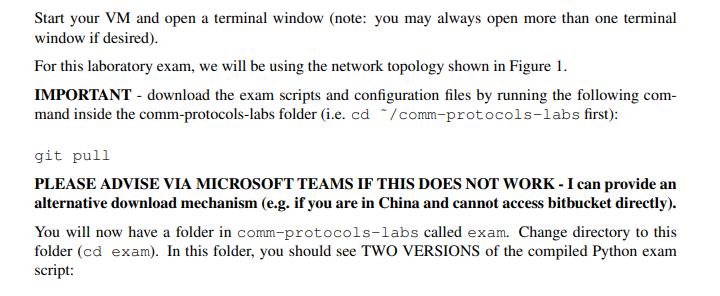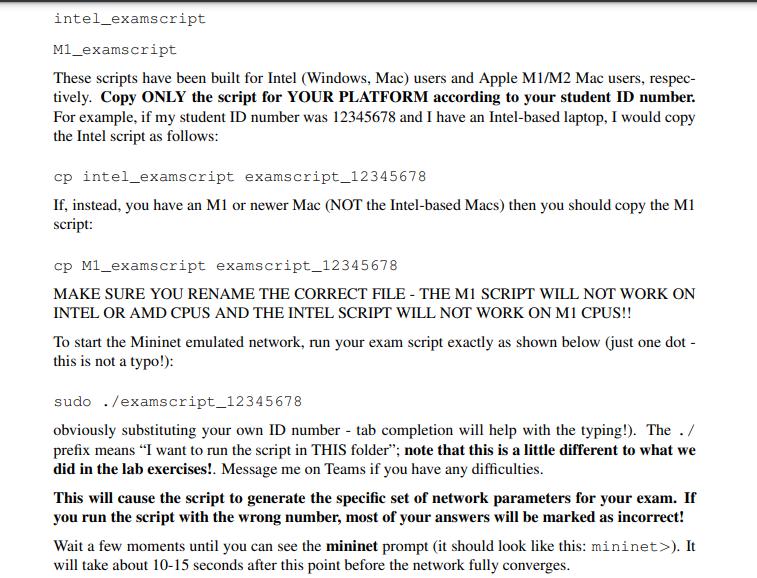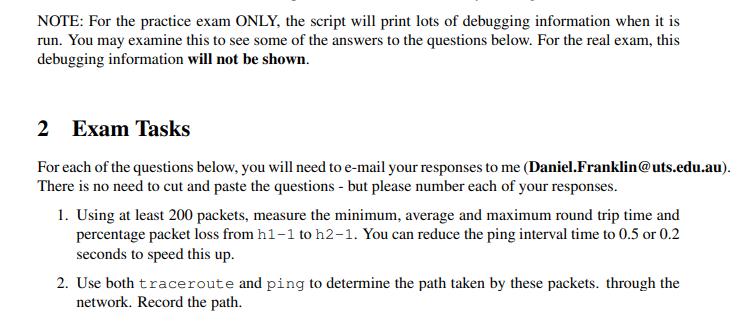Answered step by step
Verified Expert Solution
Question
1 Approved Answer
Start your VM and open a terminal window (note: you may always open more than one terminal window if desired). For this laboratory exam,
Start your VM and open a terminal window (note: you may always open more than one terminal window if desired). For this laboratory exam, we will be using the network topology shown in Figure 1. IMPORTANT - download the exam scripts and configuration files by running the following com- mand inside the comm-protocols-labs folder (i.e. cd /comm-protocols-labs first): git pull PLEASE ADVISE VIA MICROSOFT TEAMS IF THIS DOES NOT WORK - I can provide an alternative download mechanism (e.g. if you are in China and cannot access bitbucket directly). You will now have a folder in comm-protocols-labs called exam. Change directory to this folder (cd exam). In this folder, you should see TWO VERSIONS of the compiled Python exam script: h1-1 ht:1e80 10.0.1.1/4 h1-2 1-2-etho 10.0.1.2/24 h1-3 h1-3-etho 10.0.1.3/24 *** r1-eth3 10.1.4.1/28 r1-eth4 10.0.1.254/24 ri 1-ethl 10.1.2.1/28 r1-eth2 10.1.3.1/28 r4-eth1 10.1.4.4/28 13-eth1 10.1.3.3/28 14-3 10.34.4/28 13-eth3 10.34.3/28 r4 r3 5-eth1 10.3.5.254/24 14-eth2 10.2.4.4/28 r2-eth1 10.1.2.2/28 r3-eth2 10.2.3.3/28 13-eth4 10.3.5.3/24 12-eth3 10.2.4.2/28 T2 12-eth4 12-eth2 10.2.3.2/28 10.0.2.254/24 Internet Figure 1: Network topology for laboratory exam. h2-1 h2-1-etho 10.0.2.1/24 h2-2 h2-2-etho 10.0.2.2/24 h2-3 h2-3-etho 10.0.2.3/24 intel_examscript M1_examscript These scripts have been built for Intel (Windows, Mac) users and Apple M1/M2 Mac users, respec- tively. Copy ONLY the script for YOUR PLATFORM according to your student ID number. For example, if my student ID number was 12345678 and I have an Intel-based laptop, I would copy the Intel script as follows: cp intel_examscript examscript_12345678 If, instead, you have an M1 or newer Mac (NOT the Intel-based Macs) then you should copy the M1 script: cp M1_examscript examscript_12345678 MAKE SURE YOU RENAME THE CORRECT FILE - THE MI SCRIPT WILL NOT WORK ON INTEL OR AMD CPUS AND THE INTEL SCRIPT WILL NOT WORK ON M1 CPUS!! To start the Mininet emulated network, run your exam script exactly as shown below (just one dot - this is not a typo!): sudo ./examscript_12345678 obviously substituting your own ID number - tab completion will help with the typing!). The ./ prefix means "I want to run the script in THIS folder"; note that this is a little different to what we did in the lab exercises!. Message me on Teams if you have any difficulties. This will cause the script to generate the specific set of network parameters for your exam. If you run the script with the wrong number, most of your answers will be marked as incorrect! Wait a few moments until you can see the mininet prompt (it should look like this: mininet>). It will take about 10-15 seconds after this point before the network fully converges. NOTE: For the practice exam ONLY, the script will print lots of debugging information when it is run. You may examine this to see some of the answers to the questions below. For the real exam, this debugging information will not be shown. 2 Exam Tasks For each of the questions below, you will need to e-mail your responses to me (Daniel.Franklin@uts.edu.au). There is no need to cut and paste the questions - but please number each of your responses. 1. Using at least 200 packets, measure the minimum, average and maximum round trip time and percentage packet loss from h1-1 to h2-1. You can reduce the ping interval time to 0.5 or 0.2 seconds to speed this up. 2. Use both traceroute and ping to determine the path taken by these packets. through the network. Record the path. Every ten seconds, one of the client hosts connected to the left-hand switch is accessing a web page hosted on a web server running on one of the hosts attached to the right-hand switch. 3. Where is the best place in the network to run WireShark to monitor this traffic (which router or host, and which network interface) so that you can identify the active web client and server? What interface should you run the capture on? (there is only one correct answer to this question - remember, more than two hosts may be involved in this exchange). 4. Using your chosen host or router and interface, use Wireshark to determine which host is the web server and which is the client. 5. Record the size of the application layer payload of the packet containing the HTTP GET request. 6. Record the time from the first connection-establishment packet to the final connection teardown packet in the HTTP session. 7. From your Wire Shark observations of network traffic, identify the DNS request or requests occurring immediately before the client connects to the web server. Record the IP address of the DNS server. What is the size of each DNS request and response packet that you find? Make sure the DNS response matches the DNS request that you have identified! 8. What is the response time (time between sending the request to receiving the corresponding response) for the first DNS request that you observe? The remaining questions relate to TCP performance measurements. 9. Use iperf3 to measure average TCP throughput between r1 and r2 over a period of 100 seconds. Use TCP Reno. 10. Repeat this measurement, but between h1-1 and h2-1.
Step by Step Solution
There are 3 Steps involved in it
Step: 1

Get Instant Access to Expert-Tailored Solutions
See step-by-step solutions with expert insights and AI powered tools for academic success
Step: 2

Step: 3

Ace Your Homework with AI
Get the answers you need in no time with our AI-driven, step-by-step assistance
Get Started







